Abstract
Aryl-fluoroquinolone derivatives A-56619 (difloxacin) and A-56620 were found to inhibit human peripheral blood mononuclear cell (MNC) proliferation (measured by [3H]thymidine uptake) that was induced by concanavalin A or monoclonal antibody OKT3. These antimicrobial agents exert their maximum suppressive effect when added within the first 24 h after the onset of culture with concanavalin A. No increase in the concentration of mitogen or the duration of incubation of MNC cultures reversed this inhibitory effect, but the removal of the drug from cultures reversed the suppression of DNA synthesis. A-56619 appeared not to interfere with the triggering of MNC activation by mitogen because it did not inhibit mitogen-induced increase in protein synthesis (measured by [3H]leucine incorporation), interleukin-2 receptor expression (measured by the binding of fluorescein-conjugated monoclonal antibody against interleukin-2 receptor), and cell volume. These findings are considered in terms of possible interference of aryl-fluoroquinolones with mammalian topoisomerase and DNA polymerases.
Full text
PDF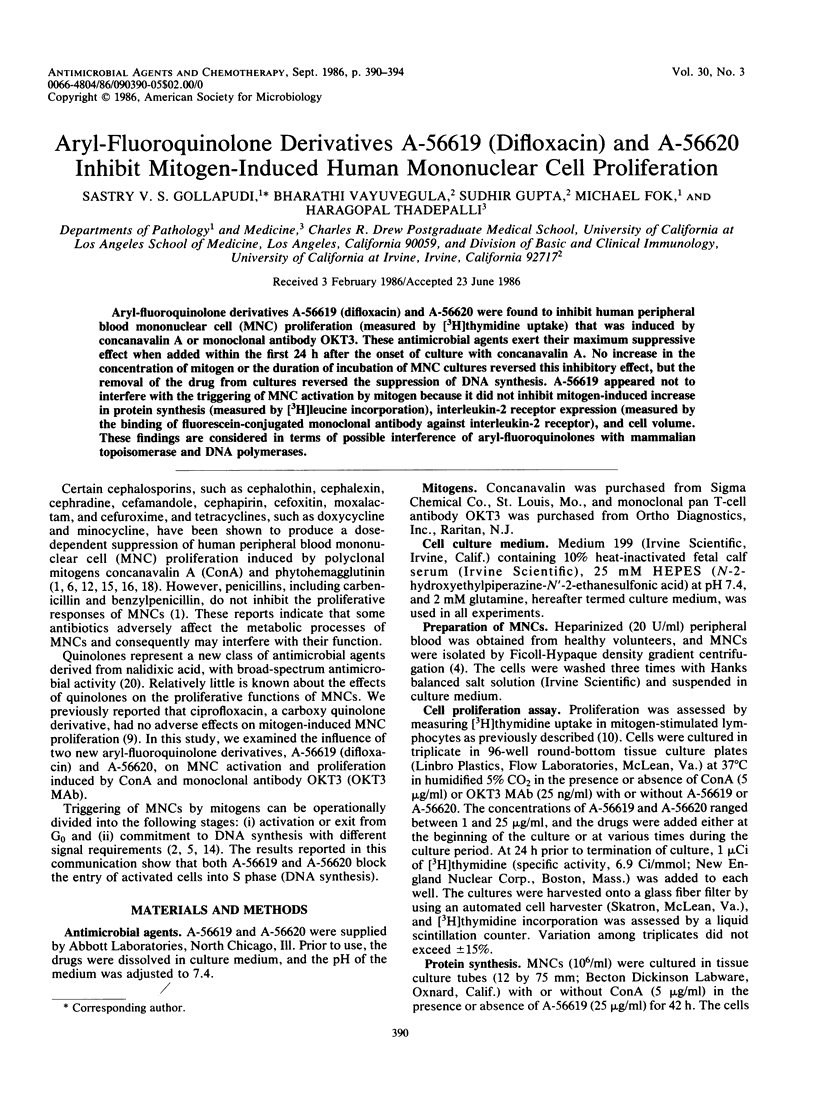
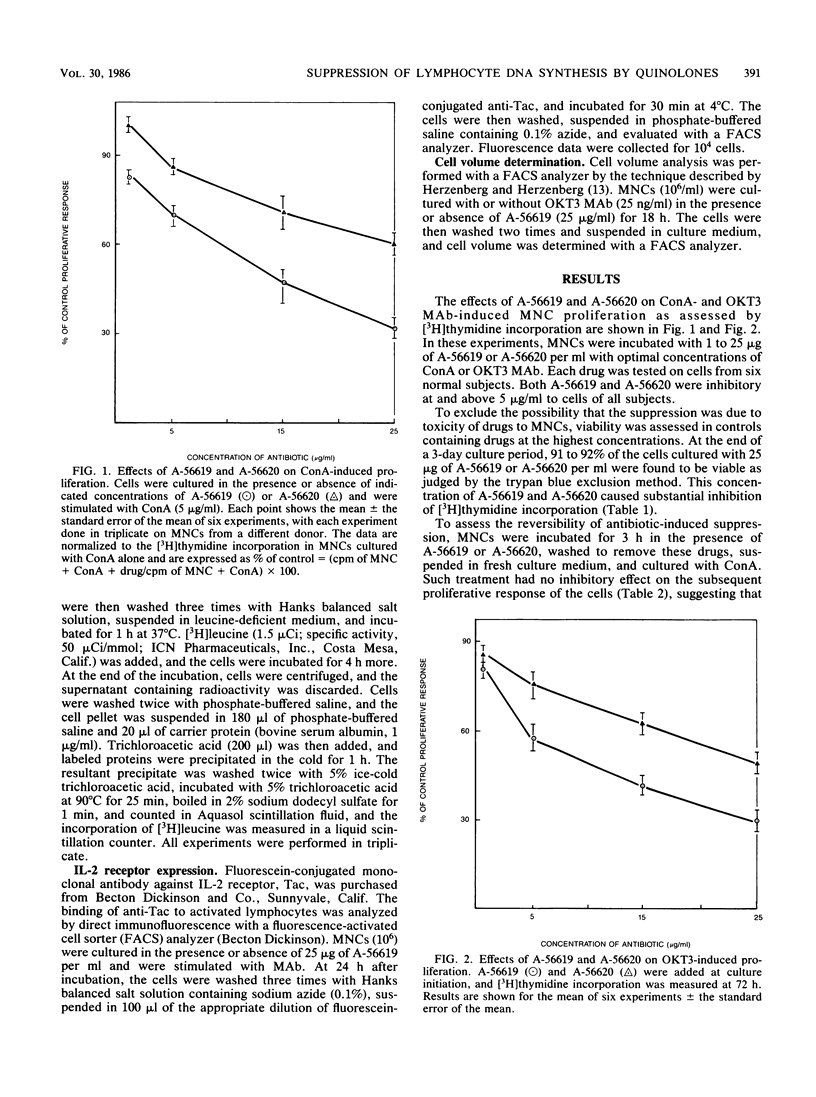
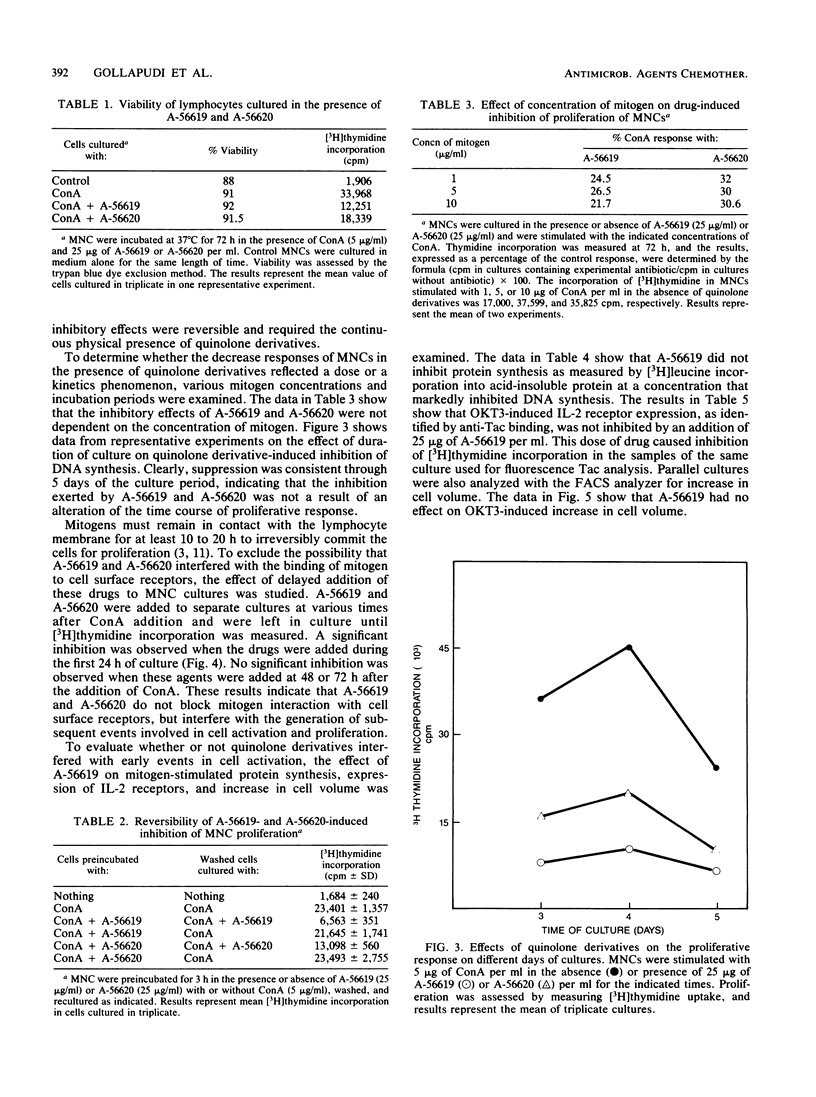
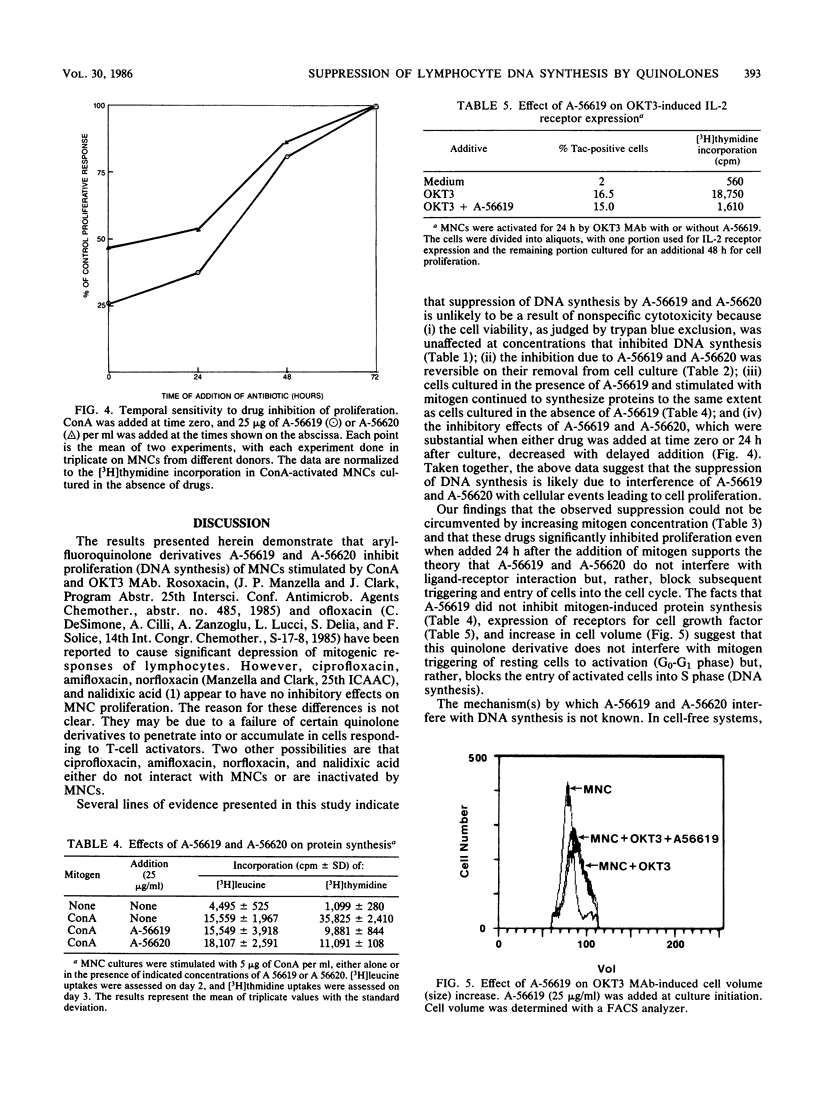
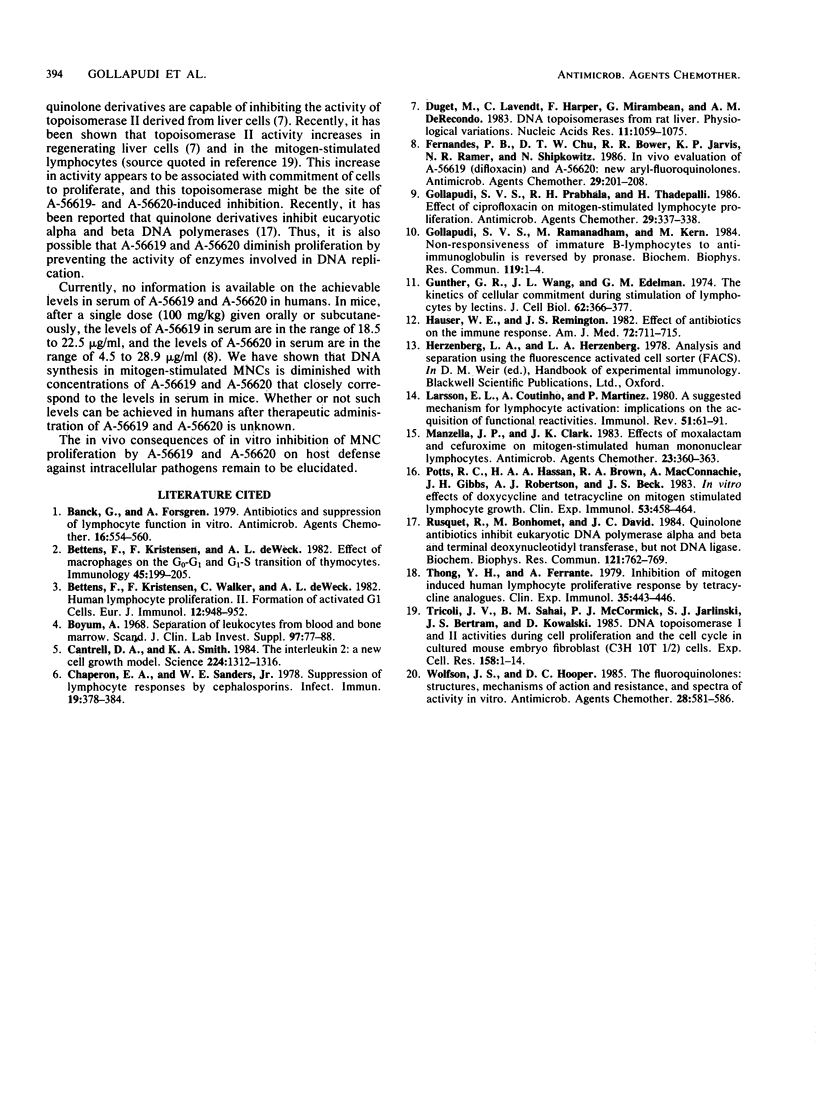
Selected References
These references are in PubMed. This may not be the complete list of references from this article.
- Banck G., Forsgren A. Antibiotics and suppression of lymphocyte function in vitro. Antimicrob Agents Chemother. 1979 Nov;16(5):554–560. doi: 10.1128/aac.16.5.554. [DOI] [PMC free article] [PubMed] [Google Scholar]
- Bettens F., Kristensen F., DeWeck A. L. Effect of macrophages on the go-gl and gl-S transition of thymocytes. Immunology. 1982 Feb;45(2):199–205. [PMC free article] [PubMed] [Google Scholar]
- Bettens F., Kristensen F., Walker C., de Weck A. L. Human lymphocyte proliferation. II. Formation of activated (G1) cells. Eur J Immunol. 1982 Nov;12(11):948–952. doi: 10.1002/eji.1830121110. [DOI] [PubMed] [Google Scholar]
- Cantrell D. A., Smith K. A. The interleukin-2 T-cell system: a new cell growth model. Science. 1984 Jun 22;224(4655):1312–1316. doi: 10.1126/science.6427923. [DOI] [PubMed] [Google Scholar]
- Chaperon E. A., Sanders W. E., Jr Suppression of lymphocyte responses by cephalosporins. Infect Immun. 1978 Feb;19(2):378–384. doi: 10.1128/iai.19.2.378-384.1978. [DOI] [PMC free article] [PubMed] [Google Scholar]
- Duguet M., Lavenot C., Harper F., Mirambeau G., De Recondo A. M. DNA topoisomerases from rat liver: physiological variations. Nucleic Acids Res. 1983 Feb 25;11(4):1059–1075. doi: 10.1093/nar/11.4.1059. [DOI] [PMC free article] [PubMed] [Google Scholar]
- Fernandes P. B., Chu D. T., Bower R. R., Jarvis K. P., Ramer N. R., Shipkowitz N. In vivo evaluation of A-56619 (difloxacin) and A-56620: new aryl-fluoroquinolones. Antimicrob Agents Chemother. 1986 Feb;29(2):201–208. doi: 10.1128/aac.29.2.201. [DOI] [PMC free article] [PubMed] [Google Scholar]
- Gollapudi S. V., Prabhala R. H., Thadepalli H. Effect of ciprofloxacin on mitogen-stimulated lymphocyte proliferation. Antimicrob Agents Chemother. 1986 Feb;29(2):337–338. doi: 10.1128/aac.29.2.337. [DOI] [PMC free article] [PubMed] [Google Scholar]
- Gollapudi S. V., Ramanadham M., Kern M. Nonresponsiveness of immature B lymphocytes to anti-immunoglobulin is reversed by pronase. Biochem Biophys Res Commun. 1984 Feb 29;119(1):1–5. doi: 10.1016/0006-291x(84)91609-7. [DOI] [PubMed] [Google Scholar]
- Gunther G. R., Wang J. L., Edelman G. M. The kinetics of cellular commitment during stimulation of lymphocytes by lectins. J Cell Biol. 1974 Aug;62(2):366–377. doi: 10.1083/jcb.62.2.366. [DOI] [PMC free article] [PubMed] [Google Scholar]
- Hauser W. E., Jr, Remington J. S. Effect of antibiotics on the immune response. Am J Med. 1982 May;72(5):711–716. doi: 10.1016/0002-9343(82)90534-4. [DOI] [PubMed] [Google Scholar]
- Larsson E. L., Coutinho A., Martinez C. A suggested mechanism for T lymphocyte activation: implications on the acquisition of functional reactivities. Immunol Rev. 1980;51:61–91. doi: 10.1111/j.1600-065x.1980.tb00317.x. [DOI] [PubMed] [Google Scholar]
- Manzella J. P., Clark J. K. Effects of moxalactam and cefuroxime on mitogen-stimulated human mononuclear leukocytes. Antimicrob Agents Chemother. 1983 Mar;23(3):360–363. doi: 10.1128/aac.23.3.360. [DOI] [PMC free article] [PubMed] [Google Scholar]
- Potts R. C., Hassan H. A., Brown R. A., MacConnachie A., Gibbs J. H., Robertson A. J., Beck J. S. In vitro effects of doxycycline and tetracycline on mitogen stimulated lymphocyte growth. Clin Exp Immunol. 1983 Aug;53(2):458–464. [PMC free article] [PubMed] [Google Scholar]
- Rusquet R., Bonhommet M., David J. C. Quinolone antibiotics inhibit eucaryotic DNA polymerase alpha and beta, terminal deoxynucleotidyl transferase but not DNA ligase. Biochem Biophys Res Commun. 1984 Jun 29;121(3):762–769. doi: 10.1016/0006-291x(84)90744-7. [DOI] [PubMed] [Google Scholar]
- Thong Y. H., Ferrante A. Inhibition of mitogen-induced human lymphocyte proliferative responses by tetracycline analogues. Clin Exp Immunol. 1979 Mar;35(3):443–446. [PMC free article] [PubMed] [Google Scholar]
- Tricoli J. V., Sahai B. M., McCormick P. J., Jarlinski S. J., Bertram J. S., Kowalski D. DNA topoisomerase I and II activities during cell proliferation and the cell cycle in cultured mouse embryo fibroblast (C3H 10T1/2) cells. Exp Cell Res. 1985 May;158(1):1–14. doi: 10.1016/0014-4827(85)90426-4. [DOI] [PubMed] [Google Scholar]
- Wolfson J. S., Hooper D. C. The fluoroquinolones: structures, mechanisms of action and resistance, and spectra of activity in vitro. Antimicrob Agents Chemother. 1985 Oct;28(4):581–586. doi: 10.1128/aac.28.4.581. [DOI] [PMC free article] [PubMed] [Google Scholar]


